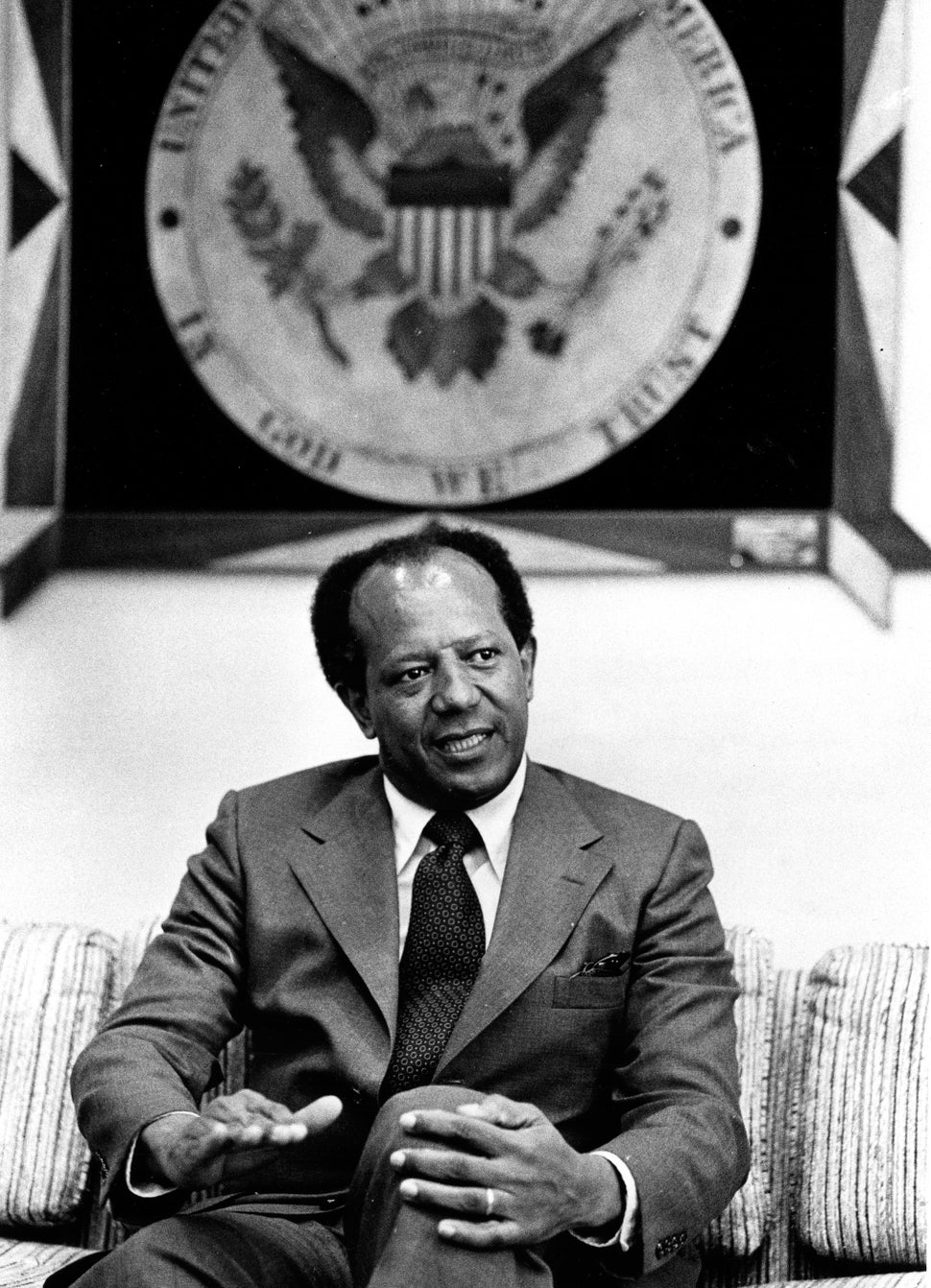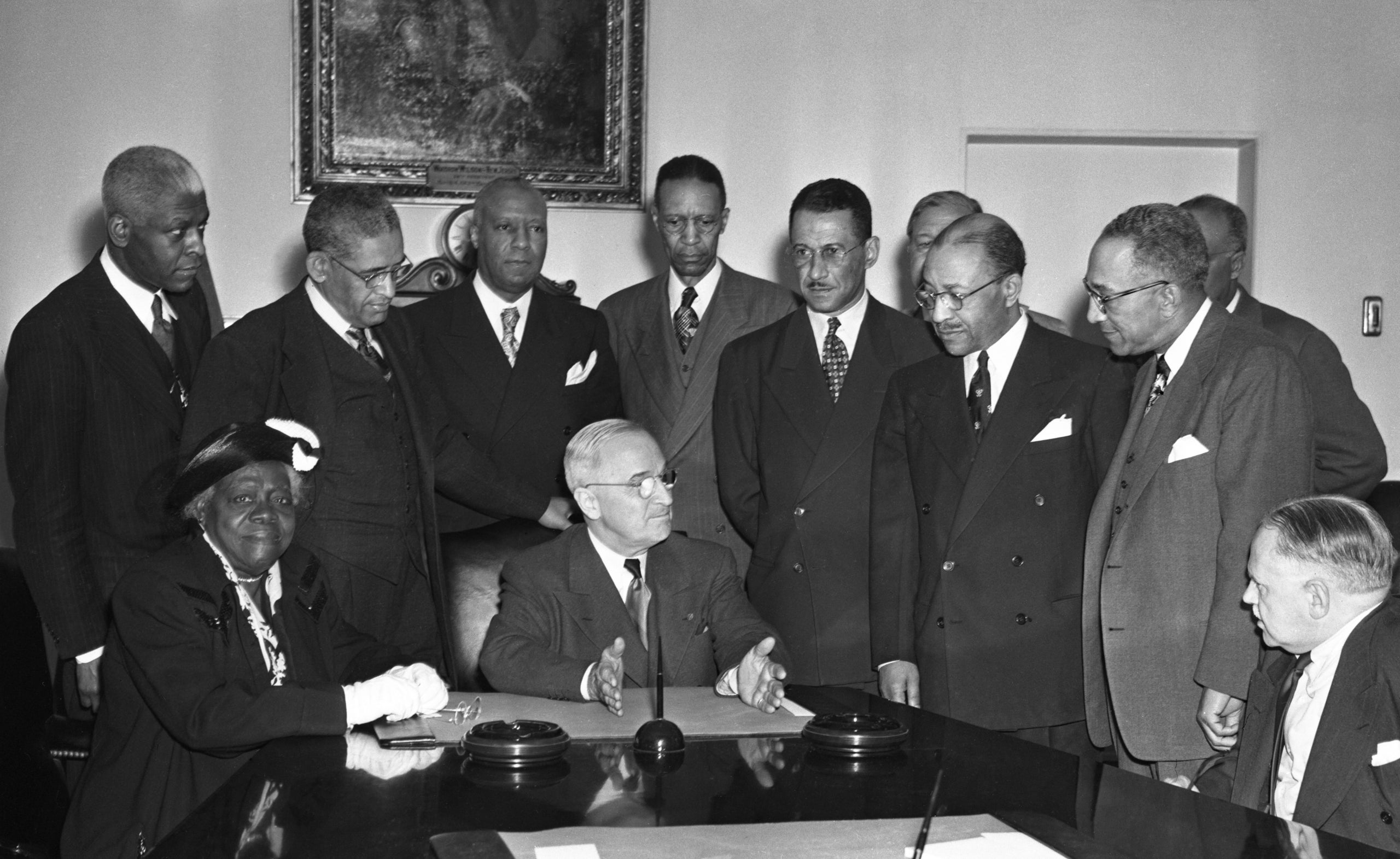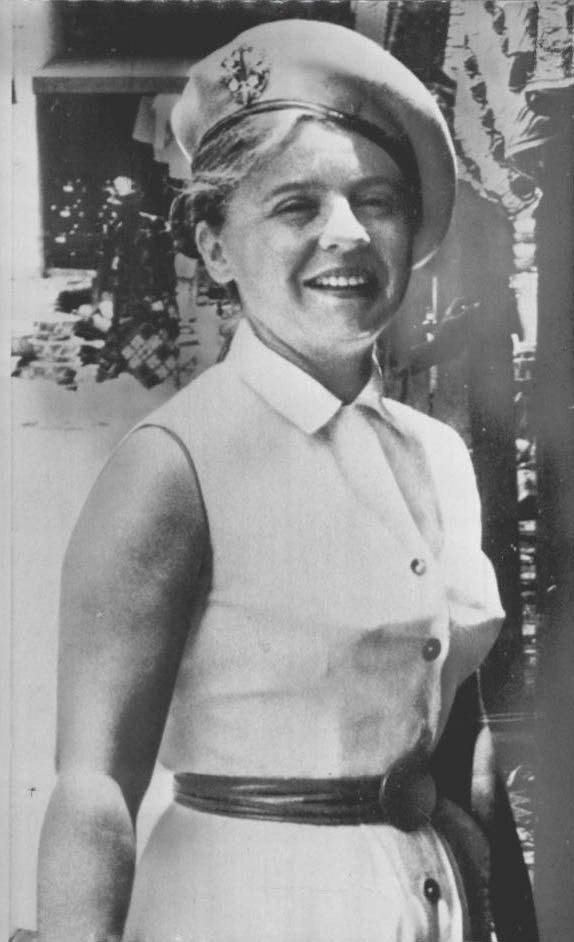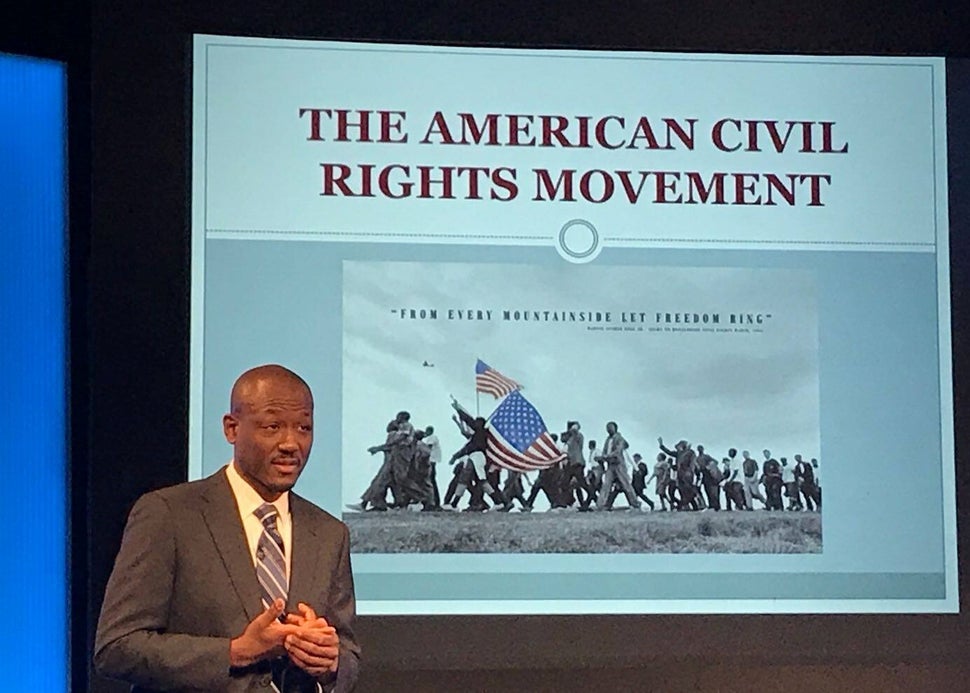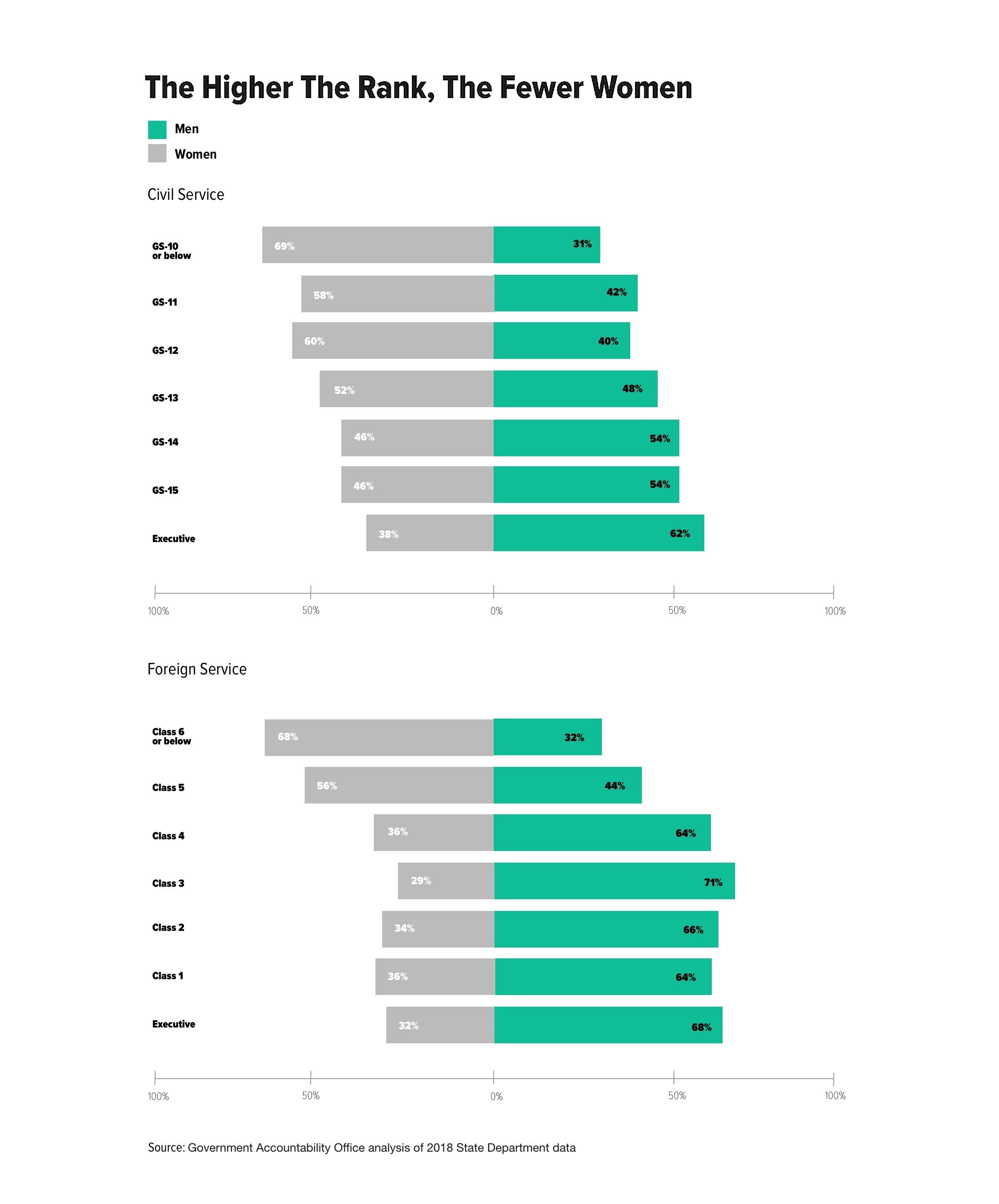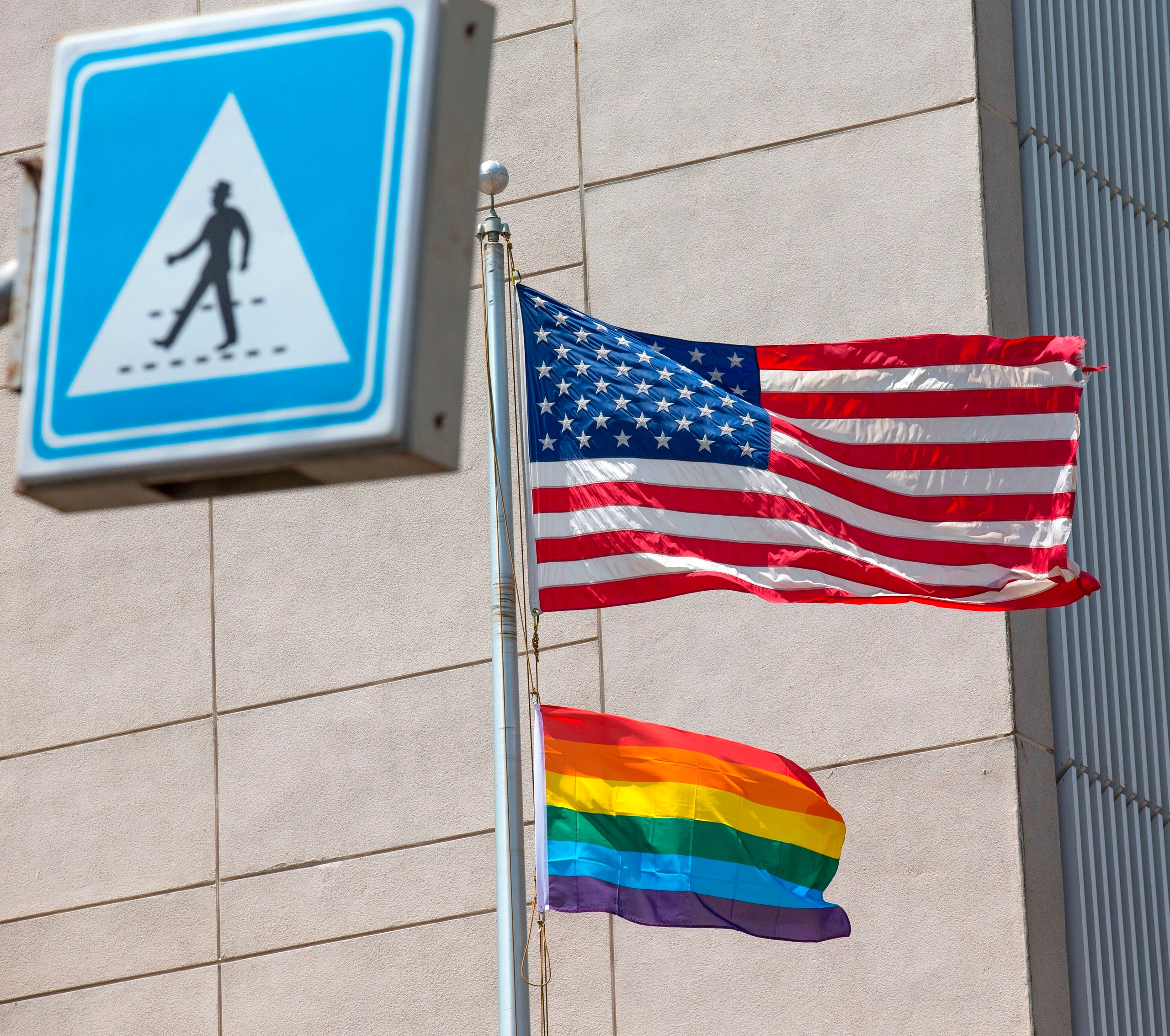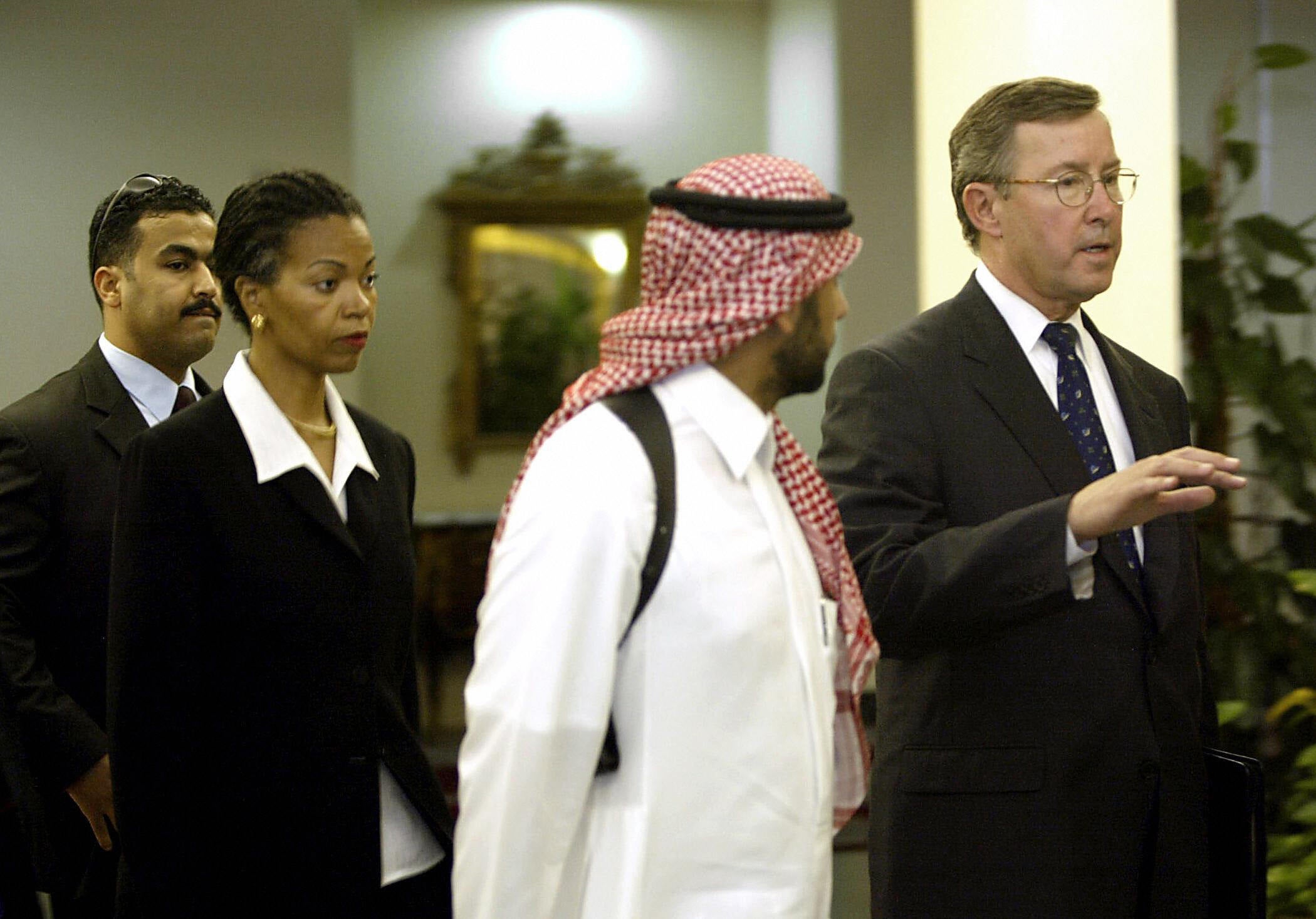Gina Abercrombie-Winstanley remembers when President Donald Trump’s first secretary of state, Rex Tillerson, promised to make the State Department more diverse. He cited one particular policy: ensuring a minority candidate was considered for all ambassador positions.
“They may not be ready, but we will know where the talent pool is,” the secretary said at an August 2017 event.
The remark deeply hurt her.
“We have been ready,” said Abercrombie-Winstanley, a veteran diplomat of ambassador rank who is a Black woman. For years, she said, ambassador selection panels had been told to prioritize diversity, and yet the top ranks of the State Department remained overwhelmingly white and male. Trump ultimately appointed 189 ambassadors ― only five of whom were Black.
“Women and minorities have long been ready, but you have to get beyond that comfort of apples choosing apples. You have to go harder,” Abercrombie-Winstanley said.
President Joe Biden has now tasked her with that work. After retiring under Trump, Abercrombie-Winstanley returned to the State Department last month as its first-ever chief diversity and inclusion officer. The high-ranking role was created so that Biden’s team can enact sweeping, overdue reform at one of the government agencies most shaken by the Trump era.
She is now one of the most powerful leaders at an institution where 86% of people in the top ranks are white, according to recently released State Department data. Last year, a major Government Accountability Office study found that promotion rates were lower for minorities and that as the agency’s staff has grown, its proportions of female and Black employees have declined.
The foreign service still disproportionately gives its best jobs to white men, according to data on promotions for the years 2016 to 2020 obtained by HuffPost. During that period, of the 26 foreign service officers elevated to career minister ― the highest rank in the service beneath a presidential appointment ― 23 were white and 17 were male. And every openly LGBTQ ambassador in State Department history has been a white man.
By pledging to make the State Department reflect the U.S., Abercrombie-Winstanley and the Biden administration are promising to succeed where 11 administrations have failed, as she explained to HuffPost in a candid interview, her first with a national news outlet since her appointment.
State Department officials and alumni have spent decades saying systemic discrimination harms employees outside the traditional “pale, male and Yale” mold of diplomats, driving many to leave and weakening the agency.
People who resist diversity, meanwhile, pay little price. Abercrombie-Winstanley noted that an officer who famously bashed Bill Clinton-era efforts at diversity continued to rise within the agency.
“Many, many other cases … frankly to this day are walking around the building and not being held to account for egregious statements,” the former ambassador told HuffPost.
She acknowledged that the State Department’s traditional response to staff facing discrimination was “to put your head in the sand, to ask employees to suffer and … suck it up.”
Abercrombie-Winstanley hopes to work fast and soon “be out of a job.” With power unlike past diversity-focused officials at the department and personal pledges from Secretary of State Tony Blinken, Abercrombie-Winstanley is already envisioning significant change a month into her tenure.
But she faces intense skepticism from a community of marginalized staffers who are used to being let down, according to interviews with and testimonials from 20 current and former officials across the State Department’s foreign and civil services.
One former foreign service officer, a Black woman who quit last year after a lengthy and successful career because of how toxic she ultimately found the department, told HuffPost she struggles to have much hope.
“The danger that we’re facing now with the department’s efforts is that they all sound wonderful, and unfortunately I’ve heard it all, serving for 20 years,” the former official said on the condition of anonymity. “The culture is deeply, deeply ingrained, and that resistance to change is like most elite white organizations: They function the way they were intended to function.”
*****
In 1957, diplomat Terence Todman started taking classes at the State Department’s Foreign Service Institute in Virginia to prepare for a job in New Delhi. Unsure about where to have lunch on his first day, he asked at the building’s small coffee shop. The response: White officers went to a restaurant across the street. But Black people could not join them.
State Department leaders told him he was overreacting when he brought it up.
“They said … no one else had complained, they had just managed to get by on it, they had taken it,” Todman recalled in a later interview.
“I said, that’s fine, they took it, but I’m not going to.”
He refused to back down, creating “a lot of unhappiness on the part of many people.” Top officials decided he was a troublemaker. But he pushed until he won: The department eventually agreed to lease half of the restaurant so that section could be racially integrated. Todman went on to become one of the best-known ambassadors in the agency’s history and the first Black person to head one of the United States’ top-tier embassies.
Nearly all progress toward equality at the State Department has come as the result of a fight.
In the meantime, countless careers have been derailed and State has lost an incalculable amount of talent.
The bureaucracy that became the foreign service accepted its first female officer in 1923, but quickly added a catch: State adopted a requirement for women to leave the service if they got married. Two years later, the service admitted its first Black officer ― and then the head of the service’s personnel board altered the selection process, ensuring no more Black people entered for another 20 years.
As Black leaders urged President Harry Truman to increase Black numbers in the federal government, the State Department found new ways to turn prejudice into policy. Starting in the late 1940s, amid the “Lavender Scare” ginned up by Sen. Joe McCarthy (R-Wis.) and his conservative allies, the State Department purged officials who were believed to be gay, costing at least 1,000 employees their careers.
By the 1960s, top officials were acknowledging that the lack of diversity hurt the agency, and President John F. Kennedy’s secretary of state, Dean Rusk, told civil rights activists in 1961 that America’s racist policies at home represented the country’s “biggest single burden on our backs” abroad.
To fix the problem, Rusk’s team promised to quickly appoint more Black officials to higher posts, survey Black staff and probe whether the foreign service admissions process was exclusionary.
But the department’s traditional power players resisted reform. Writing on the Kennedy administration’s commitment to diversity, retired diplomat Henry Serrano Villard worried that, “recent efforts could mean a motley crew indeed, composed of individuals from every walk of life” in the foreign service, according to research from State Department historian Michael Krenn.
To Todman, who was rising through the ranks when Villard published his missives, the logic was clear: “It’s an elite group and one of the ways to … maintain the sense of elitism is to not have too many people in who’ll be different.”
“Exclusion often isn’t because you hate one group or that you don’t want them,” Todman told Krenn. “It’s often because you want some others and that effectively keeps out the other side, without there being any, ‘I don’t want you around.’ It’s not, ‘I don’t want you around.’ It is, ‘I want him around and I only have room for one.’”
In 1968, the foreign service faced its first-ever gender discrimination complaint, from Alison Palmer, one of its few female employees, after three ambassadors rejected her for jobs in spite of her expertise. Though the department found in her favor, it still barred female diplomats from marrying and treated women differently with regard to admission, housing allowances and awards. Palmer launched a class action lawsuit in 1976 over State’s barriers to gender equality that carried on for nearly 34 years before the department finally ended many unfair practices and began unwinding others.
Under President Jimmy Carter, lawmakers passed the biggest reforms to the foreign service since World War II, boosting congressional oversight of the State Department ― and making another big public promise that the service would reflect America’s population.
That didn’t fix the problem either: Six years later, a group of Black diplomats sued the agency, saying Black employees consistently received poor assignments and became so demoralized they resigned, perpetuating a system in which only six of 140 ambassadors and only 12 of 635 senior foreign service officers were Black. State Department statistics at the time also showed that the percentage of recruits who were Black had fallen from 18% in 1978 to 4% in 1985.
The agency responded by creating a new fellowship program later named for Ambassador Thomas Pickering, offering to fund potential recruits’ studies to try and diversify State’s ranks. A decade later, it launched a similar program named for Rep. Charles Rangel (D-N.Y.). Both efforts are now administered by Washington’s historically Black Howard University.
But these programs are tiny relative to the agency’s deeply entrenched and deeply inflexible system, as a former foreign service officer who was one of the first Pickering fellows told HuffPost.
“No matter how many strategies administration after administration has tried … they hand it over to the foreign service to implement and to police itself. Nobody’s ever asked the question, ‘Is the foreign service capable of implementing diversity initiatives?’ And I say, no, it’s not,” the officer said, speaking on the condition of anonymity to preserve relationships.
Creating two separate groups ― one with many people of color and the other mostly white ― posed its own problems, the retired official argued.
“Now a white foreign service officer won’t say this person of color isn’t up to speed ― they will say, ‘Pickering and Rangels aren’t up to speed,’” the official said. “It’s dangerous that the only [nonwhite] people we are getting in the foreign service are coming from the fellowships. It’s another way to separate white officers from officers of color without saying what’s been implied.”
To Abercrombie-Winstanley, the handling of the fellowships over the years has clearly been marked by “racism.”
White recruits are usually not perceived as part of those programs and “do not have the same burden, so we’ve got to get the information out that regardless of who you are, you are well-prepared,” she said.
Disdain for diversity filtered through generations at the agency. In a 1994 diplomatic cable sent to U.S. missions around the world and then published in Washingtonian magazine, a State Department official named W. Lewis Amselem blasted diversity efforts as a way for the agency to overlook merit and be “conned by unscrupulous race and ethnic jumpers.”
“If you are serious about racial labels, then department medical services should be brought in to determine degrees of racial ‘purity.’ You can hire phrenologists and other experts on racial traits,” he continued. “I find diversity’s obsession with race and gender repugnant and potentially dangerous. … It is not those who object to diversity who corrode efficiency and morale in the service, it is those who promote diversity who do so.”
One of the most prominent opponents of desegregation in American history, Sen. Jesse Helms (R-N.C.), so enjoyed Amselem’s analysis that he had the document entered in the congressional record.
And as the State Department continued to lag behind its goal of representing the U.S., Amselem continued to succeed within the agency ― rising to the status of minister-counselor and winning the director-general’s award before his eventual retirement. Today, he runs a blog where he advocates slashing the agency “so that it will no longer pose a threat to the national interests of the United States” and refers to the Biden administration as “a cabal of vindictive leftoid progressives out to undo the West.”
Time after time, people who maintained the unfair status quo remained secure. After courts confirmed that both women and Black staffers faced career-marring discrimination, no State Department officials faced personal consequences for either.
*****
The most common diagnosis for State’s persistent failure to reflect America is that it can’t retain diverse staff, current and former officials said. The agency attracts people from underrepresented communities, but between mistreatment and their low chances of rising through the ranks, many quit.
Stories from current and former officials show how the career path of someone from a marginalized group can go badly wrong.
During a party at Howard University in 2004, a recruiter suggested to Patrice Johnson, then a student, that she should enter State through the Pickering fellowship. The recruiter told her “that if I had a negative approach to U.S. foreign policy at that time then I should be involved” in changing it, Johnson said. She ultimately agreed and got through the process. At her orientation, a program manager asked her to come into his office. He told her he had seen hundreds of successful foreign service officers, and the twists in her hair proved she wouldn’t be one of them, she said.
Johnson began her first assignment soon afterward. She soon noticed that her boss never assigned her to support public diplomacy programs ― experience she would need to advance her career. A few months into the job, she realized that she was alone among junior personnel in not receiving such tasks. She raised the issue to the second highest ranking official at the mission. For the rest of her tour, her superior excluded her even more intensely.
State’s expectation of conformity to a white male standard puts success further out of reach for employees from a wide range of marginalized groups.
Sofija Korać, a naturalized citizen from Serbia, dreamed of representing the U.S. The department made fulfilling that goal nearly impossible. After she passed exams to enter the foreign service, State told her she was ineligible because she used a wheelchair and crutches ― embassies would find it hard to evacuate her, the message read, according to Korać’s testimony for a recent study from the Truman Center for National Policy.
Korać finally entered State as a civil servant, but being officially part of the team did not grant her fair treatment. When she requested an accessible parking spot in the agency’s main garage, colleagues saw no need. And when she accepted a United Nations job in New York and sought help in finding housing, she was told that State had never provided such assistance before ― and that she should be grateful to have the post at all. (She is still at the U.N.)
Jenna Ben-Yehuda, a former official who now runs the Truman Center nonprofit, recalled receiving a request to work on the department’s response to a major earthquake in Haiti in 2010 after she had begun maternity leave. After she was asked to come in, the agency finally conceded that she could work from home.
“It took a humanitarian crisis for the department to allow that,” she told HuffPost. In another incident, a fellow official asked her for a leave slip when she came in half an hour late one morning ― during a period when she was overseeing $2 billion in foreign aid and was regularly working until close to midnight.
“That kind of stuff seems picayune and small-bore, but I can tell you it adds up for employees who just feel chronically undervalued,” said Ben-Yehuda, who left the agency after 12 years in 2013.
Facing bias or microaggressions, State Department officials from marginalized groups feel pressured to simply endure it.
“The motto is stay below the radar ― if I heard that once in my career, I heard it a million times,” said a retired foreign service officer who is a Black woman. “That doesn’t lend itself to being someone who talks about the challenges they face that other people don’t face.”
As the former officer worked under a verbally abusive boss for years, colleagues told her she should remember he was treating others badly, which discouraged her from pursuing a formal complaint process that would be perceived as going “against the whole culture of the institution.” She ended her 20-year career at the department after that assignment.
Chris Richardson, a former officer who is Black, said he and other staff commonly tolerated “bad behavior” ― like a white officer telling Richardson he associated Black people with welfare or officers telling Latino colleagues in 2016 that if Donald Trump became president, they would be deported.
Impunity is the norm because of how power works in the department, staffers say. Promotions depend on vague metrics like one’s “corridor reputation” ― the common term for how staff are perceived, particularly among leadership. Managers have sweeping powers and rarely face rebuke.
That structure makes officials unlikely to speak up about a range of problems. In September, the State Department’s inspector general reported that 47% of randomly selected employees who witnessed sexual harassment said they never reported it.
In testimonials gathered by supporters of legislation to strengthen anti-harassment policies at the agency, former State Department employees described sexual abuse and demeaning experiences of trying to get accountability.
One retired officer said that after she declined her harasser’s request to meet outside work, he told her he would “never say a bad word” about her ― implying that he could if she spoke out. She noted that State’s current system permits a harasser to write the review of the employee he harassed, even if he is removed from his post, and that the agency regularly promotes officials who are under scrutiny in equal employment opportunity complaints and lawsuits.
“All State Department reporting mechanisms favor the perpetrator,” she argued.
Staff experiencing toxic environments can try to move elsewhere in the department.
Johnson did that when she was harassed while serving in Colombia by locals who repeatedly refused to accept that she was an American diplomat because she was Black. She picked an assignment that was considered a hardship, in Baghdad, because “it was better to be at war in Iraq,” she said. There, she met her first State Department mentor, who told her he had experienced how it felt to be different in the department as a young Jewish man decades earlier ― and concluded that the best response was “to activate who you really are and use that as your weapon.”
Still, what worked for one official is not a uniform solution: Current official Maryum Saifee, a South Asian American, recalled that when she was doing consular work in Baghdad, Iraqis would often point to the white, blonde officer at the next window and ask her, “Can I get a redo with a real American?” (Saifee spoke with HuffPost in a personal capacity; she also helped lead the recent Truman study.)
And the procedure for getting new assignments leaves significant room for discrimination, another retired foreign service officer told HuffPost, pointing to the fact that crucial and decisive assignment panels are composed of people who volunteer to be on them, usually white men.
For civil servants ― whose ranks have historically been more diverse than those of the foreign service ― moving through the department is even harder because its most important positions are nearly always filled with foreign service officers or political appointees. The former foreign service officer described the relationship between the two groups of State Department employees as guided by a “plantation mentality.”
“You have what’s mainly lots of Black and minority administrative support staff who maintain the institution while others go out and create policy,” the officer told HuffPost.
People might be committed to the civil service because they are passionate about public service and international relations but do not want to move every two years. Transferring over to the foreign service could force them to lose a pay grade and status. Or they may have mitigating circumstances: for LGBTQ individuals like one current civil servant who spoke with HuffPost, a foreign service career could involve multiple tours in places where they would face severe restrictions and discrimination.
“I don’t see a whole lot of spaces where I’ll be able to move up,” the civil servant told HuffPost on condition of anonymity to avoid retaliation. In his current bureau, only one of five deputy assistant secretaries ― the lowest rung of senior leadership ― is a civil servant. That rank is widely seen as the highest available to the civil service, the civil servant said.
To seek those highest-ranking positions as a foreign service officer is easier on paper, but the opaque and deeply subjective process is hard to maneuver for historically underrepresented groups.
“It became clear to me that I don’t know the key,” said the former foreign service officer who retired last year. “You do get the feeling that there’s a memo circulating that you just don’t have access to.”
For many State Department employees from marginalized communities, leaving eventually looks like the best option.
After developing medical issues from multiple challenging foreign assignments, Johnson sought support from the department. Instead, she was denied the accommodations she requested and was threatened with losing her job. After taking time to heal and identifying a new career path through business school, she left two years after.
“The department has zero interest in protecting people who need protection, and the people who need protection are and have always been women, people of color and the disabled,” Johnson said.
Michael Veasy, a repeatedly decorated foreign service officer and a Black man, hit his limit after a change in leadership at his bureau in 2008, according to the Truman report. His new boss began assigning far fewer people of color to top consular posts and indicated she did not believe Veasy could handle his role running one of the busiest posts, in Tijuana, Mexico; she frequently asked his staff to share information directly with her instead. As the victimization became more evident, one of her deputies directly asked Veasy if he was considering filing an equal employment opportunity complaint. Two of Veasy’s Black staffers quit the department.
Veasy became so determined to leave that he sought early retirement and asked senior leaders not to consider him for a promotion. No one asked why. No one sought an exit interview. He ended his 22-year career with one conclusion, he said: “The department didn’t care.”
A State Department spokesperson who was asked to respond to the stories shared with HuffPost said the department is strengthening diversity and inclusion efforts at every level, citing the growth in councils focused on the issue at diplomatic facilities and a new exit survey process.
“We have also made great inroads in expanding workplace flexibilities, and strengthening accountability,” the spokesperson wrote in an email. “There is more work to be done.”
The spokesperson said the experiences of HuffPost’s interviewees “likely do not reflect the current anti-harassment policies and procedures” at the State Department’s Office of Civil Rights. “We highly encourage these individuals to contact [the office] directly … [the office] is grateful for, and welcomes, all feedback.”
*****
Trump brought the State Department “to the brink of failure and collapse,” a congressional report found last summer. Beginning with a hiring freeze and implicating the agency in racist policies like his Muslim ban, and then consistently treating diplomats as political opponents, he pushed morale at the agency down from near the top of the annual “Best Places to Work in the Federal Government” ranking to near the bottom.
Officials from marginalized communities who were already vulnerable felt a new degree of risk.
State Department employees who identified as Muslim had previously supported each other in small ways. They began to gather in conversations that “felt like group therapy,” said current official Razi Hashmi. Over four years, those discussions led to the creation of a Muslim employee affinity group called Mosaic, which officially launched internally in January.
A high-profile early case showed the importance of such solidarity: After conservative media smeared Iranian American official Sahar Nowrouzzadeh, Trump’s team demoted her. A subsequent report from the State Department inspector general found that White House staff suggested she was disloyal to the president because she was born in Iran. (She was not.)
And the Trump era forced some officials who were previously shielded by layers of privilege to confront discrimination for the first time.
Wes Reisser, a civil servant, said he “never thought” he would file an equal employment opportunity complaint “as a middle-aged white guy,” anticipating he would deal with the process primarily as a manager seeking to support his staff. Then he felt he had no choice, once a Trump administration appointee targeted him on the basis of his sexual orientation.
“It was an incredibly challenging and painful experience … that proved to me that the department really didn’t have the tools in place to be able to help people when they were illegally targeted by those above them in the chain of command,” Reisser said at an event to introduce the Truman Center study. The incident “opened my eyes to how much needed to be fixed and helped me empathize better with those who have been through far worse.”
Many of his colleagues were in for a similar reckoning.
On May 30, 2020, five days after police officer Derek Chauvin killed George Floyd, former diplomat Tianna Spears, a Black woman, published a detailed account of being repeatedly and violently subjected to racist treatment by fellow U.S. officials at the American border while serving in Juárez, Mexico. Spears drew a powerful link between the discrimination many State Department officials had experienced for decades and the nation’s broader refusal to address racial injustice.
As Spears and people who agreed with her demanded change both publicly and privately, she noted that the moment could easily slip away ― that resistance to change was a historic problem at the agency.
More than a month after her original, high-profile post, she published another as a letter to the agency.
“Five days ago, I received a message from a former U.S. diplomat explaining their personal experience with racism, sexism, and discrimination on the U.S.- Mexico border,” Spears wrote. “To my horror, it was 30 years ago. How is it that I have a shared trauma with someone that started their State Department career before I was born?”
*****
Around the time Abercrombie-Winstanley entered her role as State’s chief diversity officer, a high-ranking colleague called her. “We’ve done the easy stuff,” Abercrombie-Winstanley was told. Her takeaway: “Everything before us is difficult.”
Abercrombie-Winstanley frequently cites her own history with State as a prime reason for staff to trust her in her work. She told HuffPost she knows how it feels to debate whether or not to report misconduct, fearing retaliation or continued impunity; to hear about horrifying mistreatment of staff who are foreign nationals, particularly women; and to decline to share demographic information on surveys.
Her allies describe her personal reputation as her biggest asset. Saifee, who helped draft the recent Truman study but is not officially involved in Abercrombie-Winstanley’s effort, called the new diversity officer “a unicorn,” different even from other people of color who have taken top jobs.
“She has the confidence of those closest to the pain,” said Saifee, who has been in the foreign service since 2008.
Abercrombie-Winstanley told HuffPost she plans to fight on a number of fronts. She hopes to change the thinking among power players across the agency. Among managers and ambitious lower-level officials, she wants to make clear that being perceived as a successful leader is about “taking care of your people” ― not trying to avoid the appearance of trouble. In a new role on promotion boards, she wants to leave a lasting impact by reminding fellow leaders to consider a wider range of candidates.
“I will not long be the only voice making these observations,” Abercrombie-Winstanley said. “My job is to get everybody thinking about this.”
She is interested in funding a new reporting mechanism for staff from across the three groups of State Department employees ― the foreign service, civil servants and local staff employed in foreign countries ― to flag misconduct before it gets worse.
Eventually, she also wants to use the department’s “suitability clearance” process to ensure officials know there are professional consequences for obvious racism and sexism. “If someone is making a public broad statement that is derogatory to a group of people… is that someone who can be a trusted leader? Or someone who effectively represents the values of the United States?” Abercrombie-Winstanley said.
She can draw on a bevy of detailed outside suggestions to guide her work, from draft legislation to studies like the widely circulated Truman report collated by current State Department officials.
But the fight for diversity and inclusion could get very ugly.
Serious change should include ending State’s practice of requiring nondisclosure agreements for employees settling complaints over equal employment opportunity and harassment, multiple former officials told HuffPost, noting that other government agencies do not have a similar policy. That shift that could reveal a trove of embarrassing information.
Other powerful forces in State’s ecosystem could stymie her, as they have blocked similar reformers despite prodding. And she could face pressure to spend time on public relations, accounting for other leaders’ failures and devising diversity training and development programs, tasks that the Truman report from current State Department officials specifically said the chief diversity officer should not be forced to spend significant time on.
“I would not have taken the position if I didn’t feel empowered,” Abercrombie-Winstanley told HuffPost.
She asks to be judged on visible change: on a clear shift in accountability that changes behavior across the department and noticeable upticks in senior jobs going to people from marginalized communities. She pointed to one public choice to show her commitment to handling civil servants’ worries: her appointment of a deputy from the service. And she is prepared for things to “look worse” initially ― a development she would see as a sign of trust “because people are going to believe we’re going to do something.”
“We would not be here today if others had not spoken out,” Abercrombie-Winstanley said. “We are grateful for their bravery and a chance to make our department the model of inclusion because of their willingness to come forward and share our shortcomings, no matter how uncomfortable.”
What if forces happy with the status quo stack the odds against her? She cites widespread support from powerful partners who are not frequently affected by discrimination but understand how it has undercut the United States’ ability to craft foreign policy and its standing on the world stage.
Unlike before, Abercrombie-Winstanley said, “we have allies who maybe the system was kind of, sort of working for ― but recognize the reality is the lack of accountability hurts everybody.”
RELATED…
Source: Read Full Article

